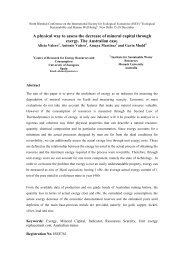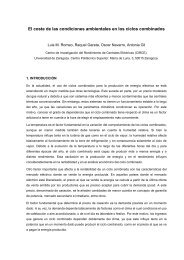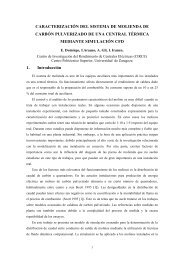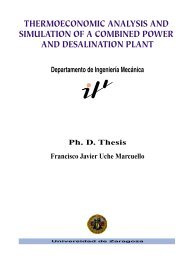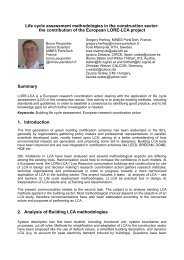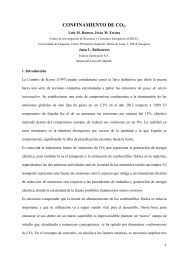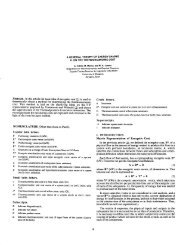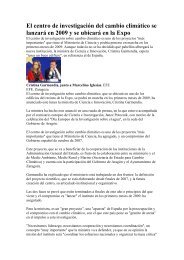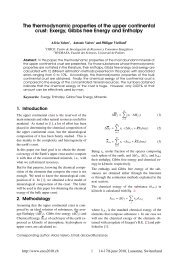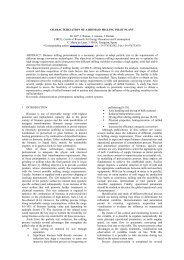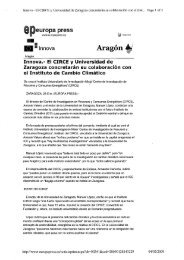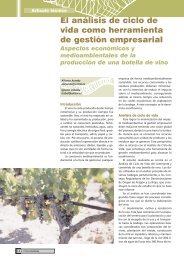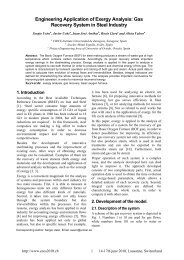APPLYING THERMOECONOMICS TO THE ANALYSIS OF ... - circe
APPLYING THERMOECONOMICS TO THE ANALYSIS OF ... - circe
APPLYING THERMOECONOMICS TO THE ANALYSIS OF ... - circe
You also want an ePaper? Increase the reach of your titles
YUMPU automatically turns print PDFs into web optimized ePapers that Google loves.
Proceedings of ECOS 2009 22 nd International Conference on Efficiency, Cost, Optimization<br />
Copyright © 2009 by ABCM Simulation and Environmental Impact of Energy Systems<br />
August 31 – September 3, 2009, Foz do Iguaçu, Paraná, Brazil<br />
Table 3. Production costs due to fossil fuel, recycling 10% biomass<br />
Fossil Fuels<br />
Process P c (GJ/GJ) C P (GJ)<br />
1 0 0<br />
2 0.08 5<br />
3 10.15 19.29<br />
4 4.45 13.79<br />
5 9.19 33.08<br />
Total 33.50<br />
Table 3 shows the new costs due to fossil fuels. As it can be seen, recycling 10% of crop residues reduces the fuel<br />
consumption by 2 GJ, or what is the same, the ratio between the fuel required and the energy consumption is reduced by<br />
5.25%.<br />
3.3. Process efficiency impact<br />
In this scenario we will assume that the efficiency of each single process is increased by 10% without modifying<br />
the final demand and the system structure (junction ratios). Eqn (7) is used for this purpose, with Δ κi<br />
= 0.1.<br />
The impact<br />
in resources consumption is decomposed into the part coming from biomass and from fossil fuels (see table 4).<br />
Table 4. Impact of resources consumption with a 10% increase on the process efficiency<br />
Process 0 C Δ Fossil Fuels (GJ) 0 C Δ Biomass (GJ) 0 C<br />
Δ Total (GJ)<br />
1 0.000 0.00% 6.000 7.50% 6.000 5.19%<br />
2 0.627 1.77% 7.881 9.85% 8.507 7.37%<br />
3 0.060 0.17% 0.216 0.27% 0.276 0.24%<br />
4 0.254 0.71% 0.094 0.12% 0.347 0.30%<br />
5 2.514 7.08% 5.808 7.26% 8.322 7.21%<br />
Eqn. (10) is used to compute the fuel impact of each efficiency simulation. The cost of fuel is evaluated for the<br />
simulated scenario and the production corresponds to the base case.<br />
i<br />
0<br />
Δ C0 = cF, iΔ κi<br />
Pi<br />
(10)<br />
Note that improving the efficiency of the last stage of the food chain has an important impact on the fossil fuel<br />
consumption. On the other hand improving the efficiency of the first stages of the process has an impact only on the<br />
reduction of biomass requirements. An important conclusion can be thus drawn: for improving the energy efficiency of<br />
the food chain, major efforts should be focused on the last production stages.<br />
3.4. Change in the food diet<br />
The last scenario analyzes a change in the diet. As it has been shown, the production of animal food requires much<br />
more resources than vegetable food. In the base model a person consumes 62% of vegetables and 38% of animal food.<br />
What would happen if we reduced the consumption of meat by 10% maintaining the final demand of energy per person<br />
in 3.6 GJ?<br />
To simulate this scenario we must change the junction ratios q 35 = 0,38 → 0,318 and q 45 = 0.62 → 0.682 . The rest<br />
of the parameters are kept constant. Eqn. (7) can be used to compute the resources consumption impact for this<br />
simulation as:<br />
Δ C0 = ( cP,3Δ q35 + cP, 4Δ q45) F5<br />
(11)<br />
Using Eqn. (11) with the unit production cost due to fossil fuel and biomass, the change implies a saving of 10.74<br />
GJ (13.42 %) of biomass resources, and 2.04 GJ (5.73 %) of fossil fuels.<br />
On the other hand, if we would reduce the energy demand per person by 10%, the associated saving would be equal<br />
to 3.49 GJ (9.84%) of fossil fuels and 7.33 GJ (9.16 %) of biomass, which could be computed using the expression:<br />
Δ C0 = cP, 5Δ E50<br />
(12)<br />
In these simulations we have differentiated between fossil fuel and biomass resources. The first one has an explicit<br />
cost: it has a market price, an environmental impact, externality costs, etc. The second one is a different case, since<br />
biomass energy is provided by the sun which is “free”. Nevertheless, the solar energy provided to biomass is<br />
proportional to the harvest area. Furthermore in this model we are considering the energy consumed per habitant,<br />
891



